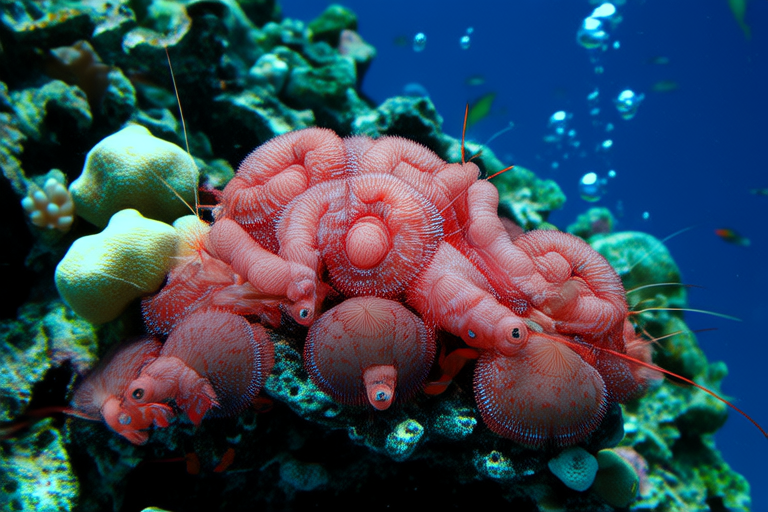Secrets to Successfully Raising Coral Shrimp in Your Home Aquarium
Introduction: Coral shrimp have gained significant popularity among aquarium enthusiasts for their vibrant colors and unique behavior. These small crustaceans, scientifically known as Stenopus hispidus, are native to the Indo-Pacific region and are often found in coral reefs. Their distinct appearance, characterized by red or orange bodies and white spots, makes them a standout addition to any saltwater aquarium. Coral shrimp are also known for their cleaning habits, feeding on algae and detritus, which can help maintain the cleanliness of your tank. Their active nature and interesting interactions make them a joy to observe. This article will guide you through the essentials of setting up a thriving coral shrimp habitat, from tank setup and water conditions to diet and breeding.
Creating the Ideal Tank Setup
To ensure the well-being of your coral shrimp, it’s crucial to provide them with an environment that closely mimics their natural habitat. Start by choosing a tank size of at least 30 gallons, which provides ample space for the shrimp to explore and establish territories. A larger tank can accommodate more shrimp, reducing stress and competition for resources.
The substrate should be composed of fine sand or crushed coral, which allows for easy burrowing and helps replicate the ocean floor. Decorate the tank with live rock, which not only adds aesthetic value but also provides hiding spots and surfaces for beneficial bacteria to grow. Live rock also encourages the growth of algae, offering the shrimp a natural food source.
In terms of lighting, choose LED fixtures that emit a spectrum of light similar to sunlight, promoting the growth of algae and enhancing the vibrant colors of the shrimp. However, avoid overly intense lighting, as it can cause excessive algae growth, leading to imbalanced tank conditions.
Water Parameters and Filtration Systems
Consistent water quality is paramount for the health of coral shrimp. Maintain a specific gravity between 1.023 and 1.025, ensuring salinity levels are appropriate for marine life. The pH should range between 8.1 and 8.4, and ammonia and nitrite levels should remain undetectable. Regular water changes, typically 10% weekly, help maintain these parameters.
A robust filtration system is essential for removing waste and maintaining water clarity. Choose a filter that incorporates mechanical, chemical, and biological filtration methods. Mechanical filtration traps debris, chemical filtration removes dissolved organic compounds, and biological filtration supports the growth of beneficial bacteria that convert harmful ammonia into less toxic substances.
Additionally, consider incorporating a protein skimmer to remove organic waste before it breaks down and contributes to water pollution. Properly maintained water conditions significantly reduce stress on the shrimp and promote a healthy living environment.
Suitable Tank Mates and Dietary Needs
Coral shrimp are generally peaceful and can coexist with a variety of tank mates. They thrive alongside small, non-aggressive fish such as cardinal tetras, blennies, and gobies. Avoid aggressive species like triggerfish, lionfish, or large predatory fish that might prey on the shrimp. Invertebrates like hermit crabs and sea stars are compatible, provided they are not too large or aggressive.
Dietary needs are another critical aspect of coral shrimp care. They are omnivorous, feeding on algae, detritus, and small particles of meat. Supplement their diet with high-quality commercial foods designed for marine invertebrates. Offer a varied diet consisting of frozen brine shrimp, mysis shrimp, and algae wafers. Additionally, encourage natural feeding by providing ample live rock and encouraging the growth of algae.
Breeding Behaviors and Tips for Maintaining a Thriving Population
Successfully breeding coral shrimp requires attention to detail and a stable environment. Establishing a pair or group of shrimp is the first step. Male and female shrimp can be distinguished by their size and color; females tend to be larger and more brightly colored. Once a pair has bonded, they will display courtship behaviors, including swimming side-by-side and touching antennae.
Females carry eggs under their abdomen for approximately three weeks before releasing larvae into the water. To maximize breeding success, maintain optimal water conditions and offer a diverse diet. Providing a shallow area with gentle water flow can simulate a natural spawning site, increasing the likelihood of successful reproduction.
Maintaining a thriving population involves regular monitoring of water parameters and ensuring sufficient hiding spaces. Avoid overcrowding, as it can lead to increased stress and aggression. By creating a nurturing environment, you can support the growth of multiple generations of coral shrimp.
Common Challenges and Solutions
Despite best efforts, some challenges may arise when keeping coral shrimp. One common issue is aggression, particularly during molting periods when shrimp become vulnerable. To mitigate this, provide plenty of hiding spots and monitor the tank for signs of stress. Another challenge is maintaining water quality, especially in smaller tanks. Implementing a rigorous maintenance schedule, including frequent water changes and thorough cleaning, can prevent issues related to poor water quality.
Shrimp can also be sensitive to sudden changes in their environment. Gradually acclimate new additions to the tank to minimize shock. If you notice any signs of disease or distress, quarantine affected individuals and consult with a veterinarian specializing in aquatic animals for appropriate treatment.
